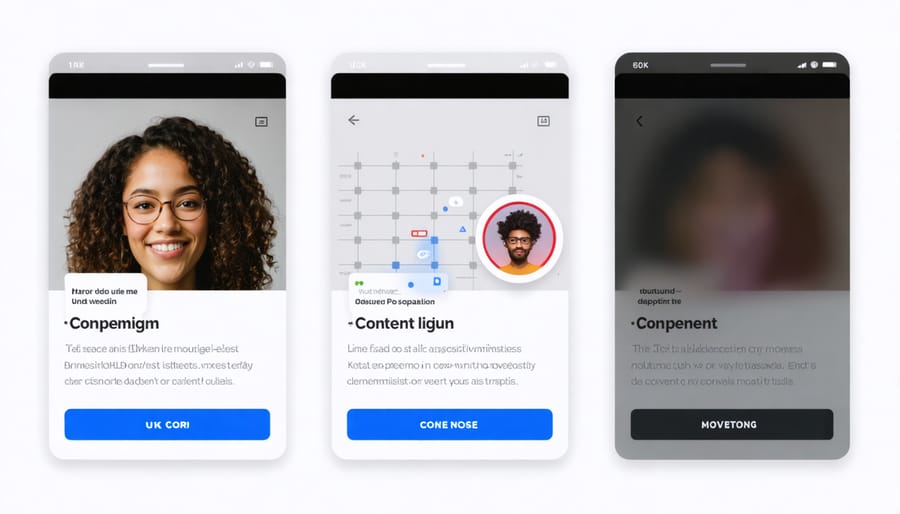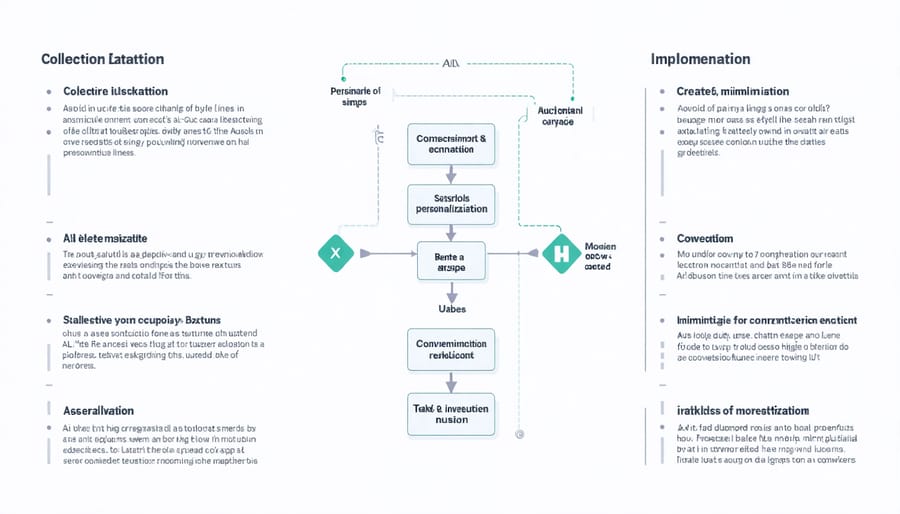Imagine stepping into a digital world that knows you better than you know yourself. That’s the promise of AI-driven personalization – a technology revolution transforming ordinary websites and apps into personalized digital experiences that adapt in real-time to each user’s unique preferences and behaviors.
Gone are the days of one-size-fits-all digital interactions. Today’s AI algorithms analyze countless data points – from browsing patterns to purchase history – creating seamless, intuitive experiences that feel remarkably human. This technological breakthrough isn’t just enhancing user engagement; it’s fundamentally reshaping how businesses connect with their audiences.
Whether you’re streaming content, shopping online, or using productivity tools, AI personalization works silently in the background, learning and evolving with every click. It’s the invisible force that suggests the perfect movie, anticipates your next purchase, or customizes your news feed with uncanny accuracy.
As we stand at the intersection of artificial intelligence and user experience, understanding AI-driven personalization isn’t just valuable – it’s essential for anyone looking to create meaningful digital connections in today’s technology-driven world.
How AI Transforms User Behavior Analysis
Real-time Data Collection
Real-time data collection forms the foundation of AI-driven personalization, acting as the digital nervous system that continuously monitors and processes user interactions. These systems track various user behaviors, including click patterns, time spent on pages, scroll depth, and search queries. They also gather contextual data such as device type, location, and time of day to build a comprehensive understanding of user preferences.
Modern AI systems employ multiple data collection methods, from traditional cookies and tracking pixels to more sophisticated approaches like heat mapping and session recording. Each user interaction creates valuable data points that the AI processes to identify patterns and preferences. For instance, when a user browses an e-commerce site, the system notes which products they view, their price range preferences, and even their shopping cart abandonment patterns.
The collected data is processed instantly, allowing the AI to make real-time adjustments to the user experience. This immediate response capability ensures that personalization remains dynamic and relevant, adapting to users’ changing needs and preferences as they navigate through digital experiences. The system continuously refines its understanding of each user, creating increasingly accurate personalization models over time.
Pattern Recognition
At the heart of AI-driven personalization lies the remarkable ability to detect and interpret patterns in user interactions. Through sophisticated user behavior analysis, AI systems can identify recurring patterns in browsing habits, content preferences, and engagement timing. These patterns emerge from various data points, such as click sequences, time spent on specific pages, and interaction frequencies.
Think of it as a digital detective that notices when you typically browse for recipes on Sunday evenings or prefer watching educational content during morning commutes. The AI doesn’t just collect this information; it actively learns from it, creating increasingly accurate user profiles over time.
What makes pattern recognition particularly powerful is its ability to predict future behaviors based on historical data. For instance, if you consistently purchase winter clothing in early October, the AI can proactively suggest relevant items before you start searching. This predictive capability enables businesses to deliver personalized experiences at precisely the right moment, making interactions feel natural and intuitive rather than forced or random.

Personalizing the User Journey
Dynamic Content Adaptation
Dynamic content adaptation through AI represents one of the most sophisticated aspects of personalization technology. As users interact with a platform, AI systems continuously analyze their behavior patterns, preferences, and engagement metrics to modify content presentation in real-time.
Consider an e-commerce website that automatically adjusts its product recommendations based on browsing history. If a user frequently views outdoor camping gear, the AI will not only showcase similar products but also adapt the content’s format – perhaps emphasizing visual content for users who engage more with images or detailed specifications for those who spend time reading product descriptions.
This adaptation extends beyond simple content selection. AI systems can modify writing styles, adjust content length, and even alter the timing of content delivery. For example, a news app might notice that a particular user prefers shorter articles during weekday mornings but engages with longer, in-depth pieces on weekends, adjusting its content presentation accordingly.
The system also learns from aggregate user data to identify broader patterns. If multiple users with similar profiles respond positively to specific content formats or topics, the AI can proactively apply these insights to new users with matching characteristics, creating a more refined personalization loop.
Modern AI algorithms can even adapt content based on contextual factors like time of day, device type, or location, ensuring that users receive the most relevant and engaging experience possible in their current situation.

Predictive User Interfaces
Modern predictive user interfaces leverage AI to create dynamic, anticipatory experiences that adapt to individual user behaviors and preferences. These intelligent systems analyze user patterns, historical interactions, and contextual data to predict what users might need before they even ask for it. By following proven AI-driven interface design principles, applications can deliver seamless, personalized experiences.
For example, streaming platforms like Netflix dynamically reorganize their interfaces based on viewing habits, presenting relevant content categories and recommendations prominently. Email clients predict and suggest responses, while productivity apps automatically surface relevant documents and tools based on user schedules and work patterns.
Smart home interfaces adjust their layouts and controls based on time of day and user routines, displaying heating controls in the morning or lighting options in the evening. E-commerce platforms modify their navigation and product placement based on browsing history and purchase behavior, making it easier for users to find items they’re likely to be interested in.
These predictive interfaces also adapt their complexity levels to match user expertise. A novice user might see simplified controls and helpful tooltips, while an experienced user receives advanced options and shortcuts. This dynamic adaptation ensures that the interface remains both accessible and efficient for all user types.
Implementation Strategies
Data Requirements
To deliver effective AI-driven personalization, organizations need to collect and process various types of data. User behavior data forms the foundation, including clickstream data, browsing patterns, time spent on pages, and interaction history. Demographic information such as age, location, and language preferences helps create basic user segments, while psychographic data reveals interests, preferences, and lifestyle choices.
Transaction data, including purchase history, cart abandonment patterns, and product interactions, provides valuable insights into consumer buying behavior. Social data, gathered from social media interactions and sharing patterns, helps understand user preferences and social influences.
Real-time contextual data is equally crucial, encompassing current location, device type, time of day, and weather conditions. This information enables immediate personalization adjustments based on situational factors.
Collection methods typically involve multiple channels:
– Website and app tracking through cookies and SDKs
– Customer feedback and surveys
– Social media monitoring
– CRM systems integration
– IoT device data
– Third-party data partnerships
To maintain data quality and user trust, organizations must implement robust data governance practices, ensuring compliance with privacy regulations like GDPR and CCPA. Data should be collected with clear user consent, stored securely, and regularly updated to maintain accuracy and relevance.
The key is to strike a balance between collecting enough data for meaningful personalization while respecting user privacy and maintaining transparency in data collection practices.

Integration Steps
Implementing AI-driven personalization requires a systematic approach to ensure successful integration. Here’s a clear process to get started:
1. Data Collection and Preparation
Start by gathering relevant user data through analytics tools, customer surveys, and interaction tracking. Clean and organize this data to ensure it’s suitable for AI processing.
2. Define Personalization Goals
Establish clear objectives for your personalization efforts. Whether it’s improving user engagement, increasing conversions, or enhancing customer satisfaction, having specific goals will guide your implementation.
3. Choose the Right AI Solution
Select appropriate AI tools and platforms that align with your goals. Consider factors like scalability, integration capabilities, and ease of use. Popular options include machine learning frameworks or ready-to-use personalization engines.
4. Start Small and Test
Begin with a pilot program focusing on one specific aspect of personalization, such as content recommendations or email marketing. This allows you to test and refine your approach before scaling up.
5. Monitor and Optimize
Implement analytics tracking to measure the effectiveness of your personalization efforts. Use A/B testing to compare different approaches and continuously refine your algorithms based on performance data.
6. Scale Gradually
Once you’ve validated your approach, gradually expand your personalization efforts across other channels and touchpoints. Ensure your infrastructure can handle increased data processing demands.
Remember to maintain transparency with users about data collection and personalization practices, and always provide options to opt out if desired.
Privacy and Ethical Considerations
As AI-driven personalization becomes increasingly prevalent in our digital experiences, it’s crucial to address the privacy and ethical implications of these systems. While personalization can enhance user experiences through accessible AI design, it also raises important questions about data collection and user privacy.
One of the primary concerns is the extensive amount of user data required for effective personalization. Companies must be transparent about what data they collect, how it’s used, and who has access to it. Users should have clear opt-in/opt-out options and maintain control over their personal information.
Another critical consideration is algorithmic bias. AI systems can inadvertently perpetuate existing biases if not properly designed and monitored. Organizations must regularly audit their AI models to ensure fair and equitable treatment across all user groups, regardless of demographics or characteristics.
Data security is equally important. Companies implementing AI personalization must invest in robust security measures to protect user information from breaches and unauthorized access. This includes encryption, secure storage protocols, and regular security audits.
The concept of “filter bubbles” presents another ethical challenge. When AI systems continuously personalize content based on user preferences, they might limit exposure to diverse perspectives and create echo chambers. Designers should implement mechanisms that maintain a healthy balance between personalized content and broader viewpoints.
To address these concerns, organizations should:
– Implement clear privacy policies and user consent mechanisms
– Regular test and audit AI systems for bias
– Provide users with transparency about personalization decisions
– Offer manual override options for automated personalization
– Ensure compliance with data protection regulations like GDPR
By prioritizing these ethical considerations, organizations can create personalized experiences that respect user privacy while delivering value. The goal is to strike a balance between personalization benefits and user protection, ensuring trust and long-term engagement.
AI-driven personalization has fundamentally transformed the landscape of UX design, creating more engaging, efficient, and meaningful digital experiences. By leveraging machine learning algorithms and vast amounts of user data, designers can now craft interfaces that adapt in real-time to individual user preferences, behaviors, and needs. This shift from one-size-fits-all to truly personalized experiences represents a significant leap forward in how we interact with digital products and services.
Looking ahead, the future of AI personalization in UX design appears increasingly promising. We’re seeing the emergence of more sophisticated AI models that can understand context, emotion, and intent with greater accuracy. These advancements will enable even more nuanced personalization, from adaptive content delivery to predictive interface adjustments that anticipate user needs before they arise.
However, this evolution comes with important responsibilities. Designers and developers must continue to prioritize user privacy, transparency, and ethical considerations as AI systems become more integral to the user experience. The key to successful implementation lies in striking the right balance between personalization and privacy, ensuring that AI enhancement truly serves the user’s best interests.
As we move forward, AI-driven personalization will likely become not just a competitive advantage but a fundamental expectation in digital experiences. Organizations that successfully harness this technology while maintaining user trust will set new standards for what’s possible in UX design.

